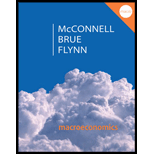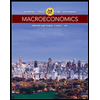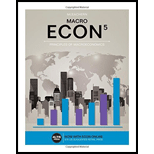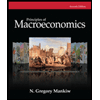
Concept explainers
Subpart (a):
Change in the balance sheet .
Subpart (a):
Explanation of Solution
When the decline in the discount rate prompts commercial banks to borrow an additional $1 billion from the Federal Reserve Banks, the commercial bank’s reserves increase by $1billion.
Thus in column (1) of the consolidated balance sheet for all commercial banks,
On the asset side,
- The commercial banks' reserves increase from $33billion to $34 billion due to the addition of $1billion from the Federal Reserve Bank.
Whereas, on the liability side
- Loans from the Federal Reserve Banks increase from $3 billion to $4 billion.
In Column (1) for the Twelve Federal Reserve Banks
On the asset side,
- Loans to commercial banks increase from $3billion to $4 billion
And on the liability side,
- Reserves of commercial banks increase from $33billion to $34 billion.
|
Consolidated Balance Sheet: All Commercial Banks | ||
| Column (1) | ||
| Assets: | ||
| Reserves | $33 | 34 |
| Securities | 60 | 60 |
| Loans | 60 | 60 |
| Liabilities and Net Worth: | ||
| Checkable deposits | $150 | 150 |
| Loans from Federal Reserve Banks | 3 | 4 |
|
Consolidated Balance Sheet: 12 Federal Reserve Banks | |||
| Column (1) | |||
| Assets: | |||
| Securities | $60 | 60 | |
| Loans to Commercial Banks | 3 | 4 | |
| Liabilities and Net Worth: | |||
| Reserves of Commercial Banks | $33 | 34 | |
| Treasury deposits | 3 | 3 | |
| Federal Reserve Notes | $27 | 27 | |
Concept Introduction:
Reserve Ratio: It is the ratio or percentage of deposit that banks must hold in liquid form.
Money Multiplier: It is the ratio of reserves to the total amount of reserves in the banking system. It is the amount that bank generates or creates with each unit of reserves.
Subpart (b):
Change in the balance sheet.
Subpart (b):
Explanation of Solution
Case two is that the Federal Reserve Banks sell $3 billion in securities to members of the public, who pay for the bonds with checks.
In the Column (2) of the consolidated balance sheet for all Commercial banks.
On the asset side,
- The reserves of the commercial banks decreases from $33 to $30 as the Federal Reserve banks reduce the reserves of $3billion held by the commercial banks as a part of clearing of the checks.
On the liability side,
- The checkable deposits fall from $150 billion to $147 billion since public pays the Federal Reserve Bank via checks from commercial banks.
In the Column (2) for the consolidated balance sheet for the 12 Federal Reserve Banks,
On the asset side,
- Securities decreases by $3 billion, from $60 billion to $57 billion as they sold to public by the Federal Reserve Bank.
On the liability side,
- There is a decrease of reserves of commercial banks from $33 billion to $30 billion as the check gets cleared.
|
Consolidated Balance Sheet: All Commercial Banks | ||
| Column (2) | ||
| Assets: | ||
| Reserves | $33 | 30 |
| Securities | 60 | 60 |
| Loans | 60 | 60 |
| Liabilities and Net Worth: | ||
| Checkable deposits | $150 | 150 |
| Loans from Federal Reserve Banks | 3 | 3 |
|
Consolidated Balance Sheet: 12 Federal Reserve Banks | ||
| Column (2) | ||
| Assets: | ||
| Securities | $60 | 57 |
| Loans to Commercial Banks | 3 | 3 |
| Liabilities and Net Worth: | ||
| Reserves of Commercial Banks | $33 | 30 |
| Treasury deposits | 3 | 3 |
| Federal Reserve Notes | $27 | 27 |
Concept Introduction:
Reserve Ratio: It is the ratio or percentage of deposit that banks must hold in liquid form.
Money Multiplier: It is the ratio of reserves to the total amount of reserves in the banking system. It is the amount that bank generates or creates with each unit of reserves.
Subpart (c):
Change in the balance sheet.
Subpart (c):
Explanation of Solution
Case three is that, the Federal Reserve Banks buy $2 billion of securities from commercial banks.
In the Column (3) of the consolidated balance sheet for all Commercial banks.
On the asset side,
- The securities held by the commercial banks decreases from $60 to $58 as the Federal Reserve banks buy $2billion of securities from commercial banks.
- Thus, by buying securities from commercial banks, the Federal Reserve Bank credits the Commercial bank with $2billion. So the reserves of the commercial bank increases from $33billion to $35 billion.
On the liability side,
- Everything (checkable deposits, loans from Federal Reserve Bank) remains unchanged.
In the Column (3) for the consolidated balance sheet for the 12 Federal Reserve Banks,
On the asset side,
- Securities increases by $2 billion, from $60 billion to $62 billion as Fed buys securities worth $2 billion.
On the liability side,
- There is an increase of reserves of commercial banks from $33 billion to $35 billion as the Fed credits the commercial banks.
|
Consolidated Balance Sheet: All Commercial Banks | ||
| Column (3) | ||
| Assets: | ||
| Reserves | $33 | 35 |
| Securities | 60 | 58 |
| Loans | 60 | 60 |
| Liabilities and Net Worth: | ||
| Checkable deposits | $150 | 150 |
| Loans from Federal Reserve Banks | 3 | 3 |
|
Consolidated Balance Sheet: 12 Federal Reserve Banks | ||
| Column (3) | ||
| Assets: | ||
| Securities | $60 | 62 |
| Loans to Commercial Banks | 3 | 3 |
| Liabilities and Net Worth: | ||
| Reserves of Commercial Banks | $33 | 35 |
| Treasury deposits | 3 | 3 |
| Federal Reserve Notes | $27 | 27 |
Concept Introduction:
Reserve Ratio: It is the ratio or percentage of deposit that banks must hold in liquid form.
Money Multiplier: It is the ratio of reserves to the total amount of reserves in the banking system. It is the amount that bank generates or creates with each unit of reserves.
Subpart (d):
Change in the balance sheet.
Subpart (d):
Explanation of Solution
|
Consolidated Balance Sheet: All Commercial Banks | ||||
| (1) | (2) | (3) | ||
| Assets: | ||||
| Reserves | $33 | 34 | 30 | 35 |
| Securities | 60 | 60 | 60 | 58 |
| Loans | 60 | 60 | 60 | 60 |
| Liabilities and Net Worth: | ||||
| Checkable deposits | $150 | 150 | 147 | 150 |
| Loans from Federal Reserve Banks | 3 | 4 | 3 | 3 |
|
Consolidated Balance Sheet: 12 Federal Reserve Banks | ||||
| (1) | (2) | (3) | ||
| Assets: | ||||
| Securities | $60 | 60 | 57 | 62 |
| Loans to Commercial Banks | 3 | 4 | 3 | 3 |
| Liabilities and Net Worth: | ||||
| Reserves of Commercial Banks | $33 | 34 | 30 | 35 |
| Treasury deposits | 3 | 3 | 3 | 3 |
| Federal Reserve Notes | $27 | 27 | 27 | 27 |
Case 1: Transaction (a) – Column (1)
The potential change in the money supply in regard to the change in reserves that is created can be calculated by using the deposit multiplier, which equals with the ratio of the maximum possible change in checkable deposits to the change in reserves.
The deposit multiplier = 0 (0/1) as there is no change in the checkable deposit even if reserves increase by $1 billion. Thus, there is no direct and immediate effect on the money supply, since the increase in reserves of commercial banks does not immediately reflect in the loans or checkable deposits after the transaction.
The reserves of the commercial banks increase by $1billion from $33 billion to $34 billion.
The reserve ratio affects the money-creating potential in two ways:-
- Changes the amount of
excess reserves - Changes the size of Money multiplier.
The money multiplier is given as 1/R where, R is the reserve ratio.
Assuming a 20% reserve ratio; the money multiplier is 5 (=1/0.20) and there is an increase in reserves by $1 billion. Also there is no change in the excess reserves as there is no change in the checkable deposit.
Thus, by combining the two factors, the money creation potential of commercial banks increase by $5billion (=$1billion x 5).
Case 2: Transaction (b) – Column (2)
There is an immediate effect on the money supply here because the banks checkable deposits have fallen by $3billion from $150to $147 billion immediately after the transaction. The deposit multiplier is 1(3/3). Thus, there is an immediate decline in the money supply by $3 billion from $33 billion to $30 billion.
The reserves of the commercial banks decreased from $33 to $30 billion.
Assuming a 20% reserve ratio, the money-creating potential of the commercial banking system has decreased by $12 billion.
Given the money multiplier is 5 (=1/0.20), the reserves has
decreased by $3 billion which implies a decrease in money creating a potential of $15billion (=5x$3 billion). Also, checkable deposits have fallen by $3 billion which results in creationof additional excess reserves of $0.6 billion (= .20 (
Case 2: Transaction (c) – Column (3)
The deposit multiplier = 0 (0/2) as there is no change in the checkable deposit even if reserves increase by $2 billion. Thus, there is no direct and immediate effect on the money supply, since increase in reserves of commercial banks is not immediately reflected in the loans or checkable deposits after the transaction.
The reserves of the commercial banks increased from $33 to $35 billion.
Assuming a 20% reserve ratio; the money multiplier is 5 (=1/0.20) and there is an increase in reserves by $2 billion. Also there is no change in the excess reserves as there is no change in the checkable deposit.
Thus, by combining the two factors, the money creation potential of commercial banks increase by $10billion (=$2billion x 5).
Concept Introduction:
Reserve Ratio: It is the ratio or percentage of deposit that banks must hold in liquid form.
Money Multiplier: It is the ratio of reserves to the total amount of reserves in the banking system. It is the amount that bank generates or creates with each unit of reserves.
Want to see more full solutions like this?
Chapter 16 Solutions
Macroeconomics: Principles, Problems, & Policies
- 19. In a paragraph, no bullet, points please answer the question and follow the instructions. Give only the solution: Use the Feynman technique throughout. Assume that you’re explaining the answer to someone who doesn’t know the topic at all. How does the Federal Reserve currently get the federal funds rate where they want it to be?arrow_forward18. In a paragraph, no bullet, points please answer the question and follow the instructions. Give only the solution: Use the Feynman technique throughout. Assume that you’re explaining the answer to someone who doesn’t know the topic at all. Carefully compare and contrast fiscal policy and monetary policy.arrow_forward15. In a paragraph, no bullet, points please answer the question and follow the instructions. Give only the solution: Use the Feynman technique throughout. Assume that you’re explaining the answer to someone who doesn’t know the topic at all. What are the common arguments for and against high levels of federal debt?arrow_forward
- 17. In a paragraph, no bullet, points please answer the question and follow the instructions. Give only the solution: Use the Feynman technique throughout. Assume that you’re explaining the answer to someone who doesn’t know the topic at all. Explain the difference between present value and future value. Be sure to use and explain the mathematical formulas for both. How does one interpret these formulas?arrow_forward12. Give the solution: Use the Feynman technique throughout. Assume that you’re explaining the answer to someone who doesn’t know the topic at all. Show and carefully explain the Taylor rule and all of its components, used as a monetary policy guide.arrow_forward20. In a paragraph, no bullet, points please answer the question and follow the instructions. Give only the solution: Use the Feynman technique throughout. Assume that you’re explaining the answer to someone who doesn’t know the topic at all. What is meant by the Federal Reserve’s new term “ample reserves”? What may be hidden in this new formulation by the Fed?arrow_forward
- 14. In a paragraph, no bullet, points please answer the question and follow the instructions. Give only the solution: Use the Feynman technique throughout. Assume that you’re explaining the answer to someone who doesn’t know the topic at all. What is the Keynesian view of fiscal policy and why are some economists skeptical?arrow_forward16. In a paragraph, no bullet, points please answer the question and follow the instructions. Give only the solution: Use the Feynman technique throughout. Assume that you’re explaining the answer to someone who doesn’t know the topic at all. Describe a bond or Treasury security. What are its components and what do they mean?arrow_forward13. In a paragraph, no bullet, points please answer the question and follow the instructions. Give only the solution: Use the Feynman technique throughout. Assume that you’re explaining the answer to someone who doesn’t know the topic at all. Where does the government get its funds that it spends? What is the difference between federal debt and federal deficit?arrow_forward
- 11. In a paragraph, no bullet, points please answer the question and follow the instructions. Give only the solution: Use the Feynman technique throughout. Assume that you’re explaining the answer to someone who doesn’t know the topic at all. Why is determining the precise interest rate target so difficult for the Fed?arrow_forwardProblem 1 Regression Discontinuity In the beginning of covid, the US government distributed covid stimulus payments. Suppose you are interested in the effect of receiving the full amount of the first stimulus payment on the total spending in dollars by single individuals in the month after receiving the payment. Single individuals with annual income below $75,00 received the full amount of the stimulus payment. You decide to use Regression Discontinuity to answer this question. The graph below shows the RD model. 3150 3100 3050 Total Spending in the month after receiving the stimulus payment 2950 3000 74000 74500 75000 75500 76000 Annual income a. What is the outcome? (5 points) b. What is the treatment? (5 points) C. What is the running variable? (5 points) d. What is the cutoff? (5 points) e. Who is in the treatment group and who is in the control group? (10 points) f. What is the discontinuity in the graph and how do you interpret it? (10 points) g. Explain a scenario which can…arrow_forwardProblem 2 Difference-in-Difference In the beginning of 2005, Minnesota increased the sales tax on alcohol. Suppose you are interested in studying the effect of the increase in sale taxes on alcohol on the number of car accidents due to drinking in Minnesota. Unlike Minnesota, Wisconsin did not change the sales tax on alcohol. You decide to use a Difference-in-difference (DID) Model. The numbers of car accidents in each state at the end of 2004 and 2005 are as follows: Year Number of car accidents in Minnesota Number of car accidents in Wisconsin 2004 2000 2500 2005 2500 3500 a. Which state is the treatment state and which state is the control state? (10 points) b. What is the change in the outcome for the treatment group between 2004 and 2005? (5 points) C. Can we interpret the change in the outcome for the treatment group between 2004 and 2005 as the causal effect of the policy on car accidents? Explain your answer. (10 points) d. What is the change in the outcome for the control…arrow_forward
 Macroeconomics: Private and Public Choice (MindTa...EconomicsISBN:9781305506756Author:James D. Gwartney, Richard L. Stroup, Russell S. Sobel, David A. MacphersonPublisher:Cengage Learning
Macroeconomics: Private and Public Choice (MindTa...EconomicsISBN:9781305506756Author:James D. Gwartney, Richard L. Stroup, Russell S. Sobel, David A. MacphersonPublisher:Cengage Learning Economics: Private and Public Choice (MindTap Cou...EconomicsISBN:9781305506725Author:James D. Gwartney, Richard L. Stroup, Russell S. Sobel, David A. MacphersonPublisher:Cengage Learning
Economics: Private and Public Choice (MindTap Cou...EconomicsISBN:9781305506725Author:James D. Gwartney, Richard L. Stroup, Russell S. Sobel, David A. MacphersonPublisher:Cengage Learning
 Essentials of Economics (MindTap Course List)EconomicsISBN:9781337091992Author:N. Gregory MankiwPublisher:Cengage Learning
Essentials of Economics (MindTap Course List)EconomicsISBN:9781337091992Author:N. Gregory MankiwPublisher:Cengage Learning Principles of Economics (MindTap Course List)EconomicsISBN:9781305585126Author:N. Gregory MankiwPublisher:Cengage Learning
Principles of Economics (MindTap Course List)EconomicsISBN:9781305585126Author:N. Gregory MankiwPublisher:Cengage Learning Principles of Macroeconomics (MindTap Course List)EconomicsISBN:9781285165912Author:N. Gregory MankiwPublisher:Cengage Learning
Principles of Macroeconomics (MindTap Course List)EconomicsISBN:9781285165912Author:N. Gregory MankiwPublisher:Cengage Learning





